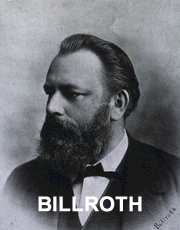This article is part of the series "A Moment in History" where we honor those who have contributed to the growth of medical knowledge in the areas of anatomy, medicine, surgery, and medical research.

Pioneers of Surgical Stapling
If you look at a desktop stapler, you will see that it is formed by very simple components: a staple, a pushing element, and an anvil that helps form the staple. This simple device has revolutionized surgery allowing surgeons to perform complex anastomoses and resections that otherwise could take a long time using sutures.
The story of surgical stapling starts with surgeons that established the parameters for a safe and leak-proof anastomosis as well as the tenets of antisepsis.
Christian Albert Theodor Billroth (1829 – 1894) set the parameters for gastrointestinal anastomoses when he developed the “Billroth I” and “Billroth II” procedures.
William S. Halsted (1852 – 1922), who started modern American medical education, set the “rules” for a good anastomosis and tissue management. Halsted preached for the use of small-gage sutures and needles, good surgical technique, and reduction of tissue trauma. Halsted proved empirically that a single-layered anastomotic suture worked as well as a double-layered suture line. Surgical staplers apply a single layer of staples.
In 1910 Halsted developed a non-suture anastomotic device, but it never went beyond the prototype stage.
The search for a safe end-to-end anastomosis led to the development of the “Murphy button” by Dr. John Benjamin Murphy (1857 – 1916) a “sutureless compression anastomotic device” in 1982, the precursor of some modern compression anastomotic devices, such as those developed by Novo GI (ex NiTi Surgical).
Continued....
The history of surgical stapling [1] ; [2]; [3]; [Video]
Sources
1. "Surgical stapling" Mallina, R F 1962 Scientific American 207, 48
2. “Science of Stapling: Urban Legend and Fact” Pfiedler & Ethicon EndoSurgery
3. “Cholecystointestinal, gastrointestinal, enterintestinal anastomosis, and approximation without sutures” Murphy JB. Med Rec (1892) 42: 665
4. “Study of Tissue Compression Processes in Suturing Devices” Astafiev, G. (1967 (USSR Ministry of Health, Ed.)
5. “Rese?as Hist?ricas: John Benjamin Murphy” Parquet, R.A. Acta Gastroenterol Latinoam 2010;40:97.
6. “The Science of Stapling and Leaks” Baker, R. S., & et al. (2004) Obesity Surgery, 14, 1290-1298.
7. “John Benjamin Murphy – Pioneer of gastrointestinal anastomosis”Bhattacharya, K., & Bhattacharya, N. (2008). Indian J. Surg., 70, 330-333.
8. “The Story of Surgery” Graham, H. (1939) New York: Doubleday, Doran & Co.. Inc.
9. “Compression Anastomosis: History and Clinical Considerations”Kaidar-Person, O, et al, e. (2008) Am J Surg, 818-826.
10. “Current Practice of Surgical Stapling”Ravitch, M. M., Steichen, F. M., & Welter, R. (1991) Philadelphia: Lea& Febiger.
11. “Aladar Petz (1888-1956) and his world-renowned invention: The gastric stapler” Olah, A. Dig Surg 2002: 19; 393-3



